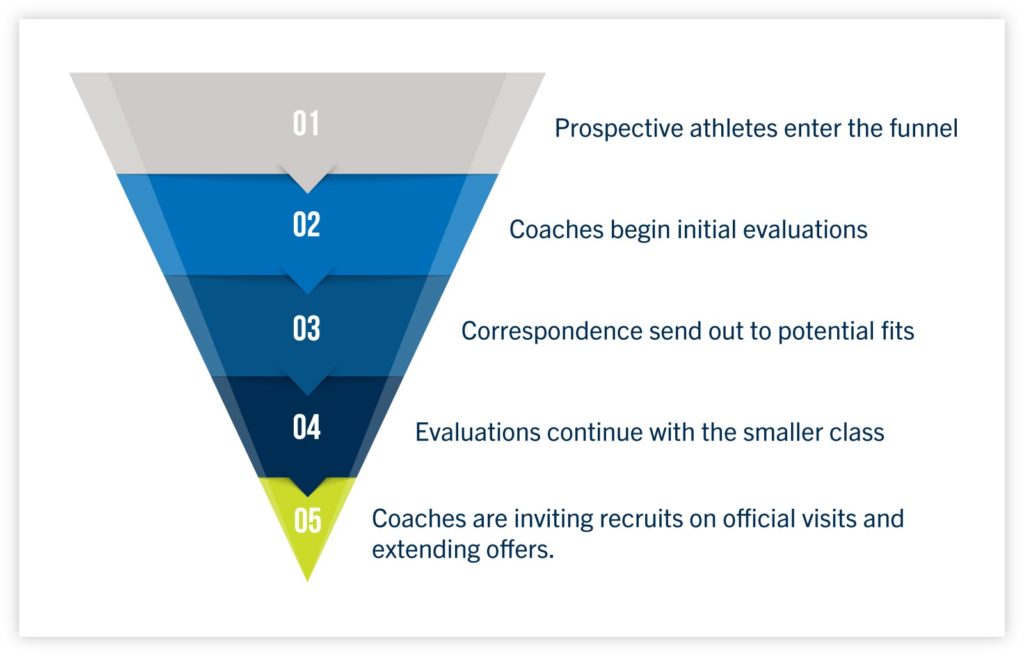The more you know about the recruiting process—and the more effort you put into getting the results you want—the better chance you have to fulfill your dream of competing at the college level. The good news is that many have gone through this complicated process before you, and there are many resources available to make it less overwhelming.

Recruiting is starting earlier and earlier each year, and it’s no secret that top athletic programs are leading the charge. They look for freshmen who have varsity or elite club film, were ranked as a top-tier recruit at a tournament or showcase or received prestigious awards, such as All-State. If this is you, you’re probably ready to start the recruiting process as a freshman.
Insider tip: Team sports tend to recruit earlier than individual sports. Team sports in heavy hitting conferences, like the Big Ten and SEC, especially move quicker in their recruiting timelines.
For athletes who hit their stride later in their sophomore year, this could be a better time to get the process going. In most cases, we advise that athletes start the recruiting process before their junior year.
Think of it this way: If you want to compete at the NCAA D1 or D2 level, the sooner you can confidently start the recruiting process, the better off you’ll be. However, if you’re a late bloomer or just not sure you want to make the commitment to compete in college, it’s OK to wait a little longer.
If you do decide to wait, make sure you’re willing to put in extra work during crunch time, and you’re comfortable with playing for lower-tier program.
Many families decide to delay the start of their athlete’s recruiting because they think that recruiting starts with contacting college coaches. And, they argue, their athlete just isn’t ready to take that step. However, there’s so much more that athletes need to do before they begin reaching out to coaches.
We’ve outlined the research and groundwork that families need to establish at the beginning of the recruiting process to ensure they are set up for success. If you’re unsure whether or not it’s too early to start the recruiting process, check out our guide to why your student-athlete should start the recruiting process and reasons why they just might want to wait by grad year.
One of the best ways to impress college coaches early in the recruiting process is by taking initiative. Rather than waiting for coaches to reach out to you, be proactive during the recruiting process.

Understanding how to get recruited starts with learning how college coaches look at recruiting. Think of the process like a funnel.
At the top of the funnel, thousands and thousands of potential recruits of various levels are tossed in. Coaches begin initial evaluations—focusing on basic requirements like height, weight, grad year and position.
Then, coaches send out correspondence to those they’ve identified as potential fits to see if there’s mutual interest.
The funnel is beginning to narrow. Evaluations continue with the smaller class of potential recruits, which narrows it down even further.
Near the bottom of the funnel, coaches are inviting recruits on official visits and extending offers. Learn more about the full college recruiting process.
Related Articles:
Getting noticed by college coaches requires student-athletes to take initiative. This starts with an introductory email that allows coaches to get to know an athlete, their academic and athletic achievements and why they are interested in the program. For getting on a coach’s radar, body language, coachability, positive leadership, and good energy on the court are all important.
For most sports, sending highlight videos to coaches is also important. You should understand:
Insider Tip: Participate in our specialized workshops for parents and student-athletes, hosted by NCSA and IMG Academy, the leaders in sports education and recruitment. Elevate your skills and insights. Sign up now!
Getting an objective view of how you stack up against other student-athletes is an invaluable component of the recruiting process—and often one of the toughest parts of the process as families learn more about how to get recruited.
There’s no point in striving for a DI scholarship if you don’t have the size or skills to compete at that demanding level.
There are a couple ways to figure out how you rank: researching college rosters and being evaluated by a third party like NCSA.
Most importantly, you should be honest with yourself about your desire to compete at the college level. It’s nothing like high school; everything is more intense, from training to the competition itself.
Learn more about the role of club sports in the recruiting process.
Once you’ve determined your level of interest, talent and expectations surrounding college athletics, it’s important to consider the various division levels available to compete in:
Explore more about each division level.
Academic eligibility is one of the most important aspects of the recruiting process and can be overlooked by families who aren’t sure how to get recruited.
There are different eligibility requirements for NCAA, NAIA and JUCO schools—and each school will also have its own entrance requirements—so it’s crucial to actively work to maintain your grades. A great GPA and/or standardized test score can be the difference-maker between you and another recruit.
Think about it: A college coach wants to fill their roster with athletes who will work hard. If you can prove you have the academic chops, they have less to worry about. Being academically sound will also open more doors for you scholarship-wise.
Discover what it takes to become academically eligible.
For international student-athletes, the college recruiting process can look a bit different. While the process starts at the same time as domestic student-athletes, there are various differences that international athletes should know about, including academic requirements.
Read our guide: The International Athletes Guide to Athletic Recruiting includes everything international athletes needs to know about getting recruited in the U.S.